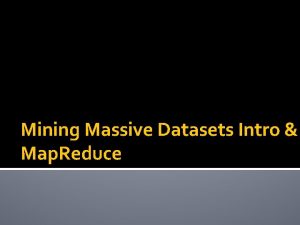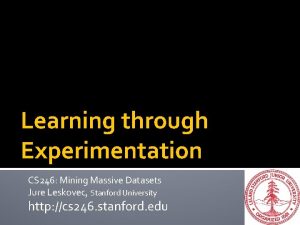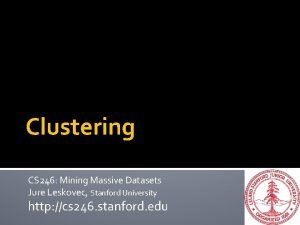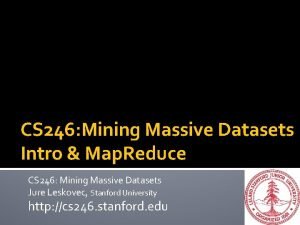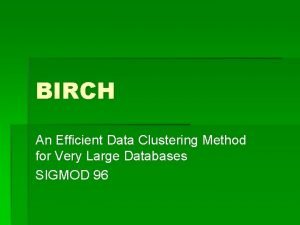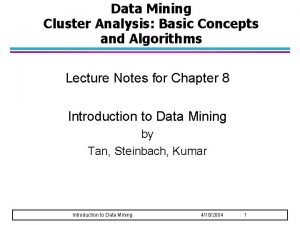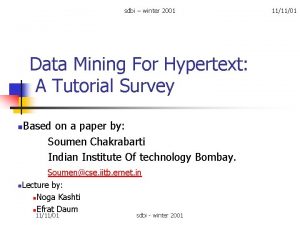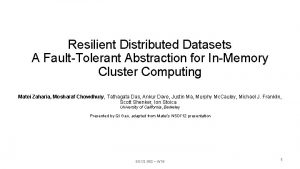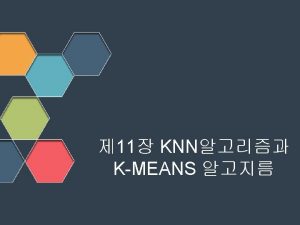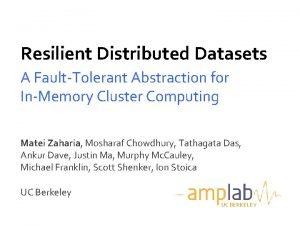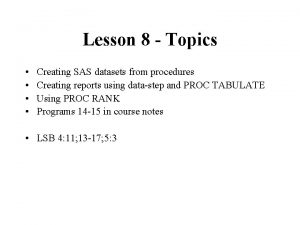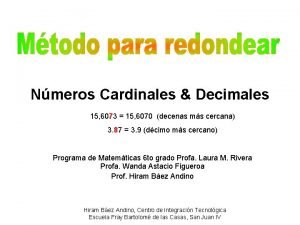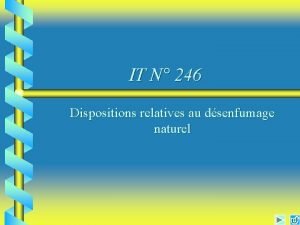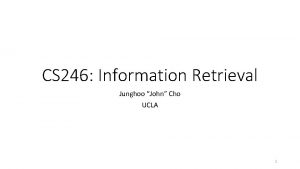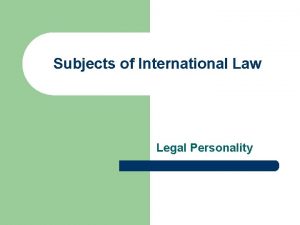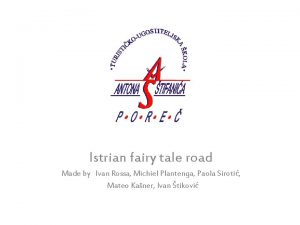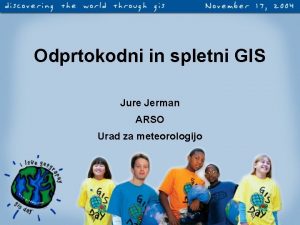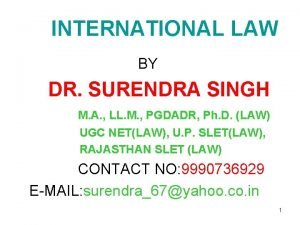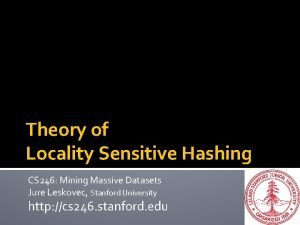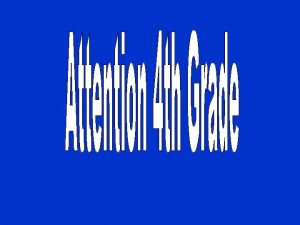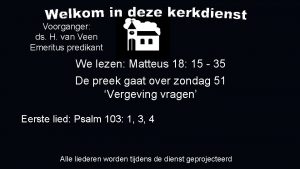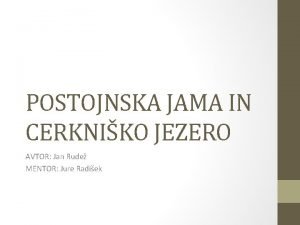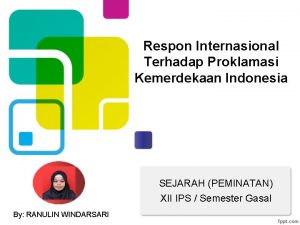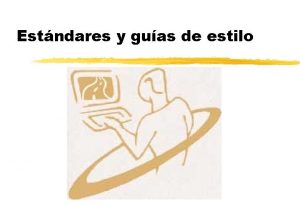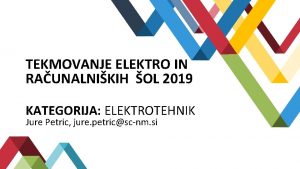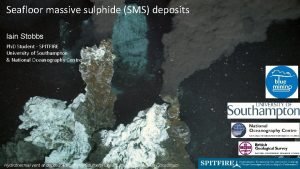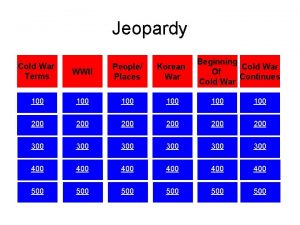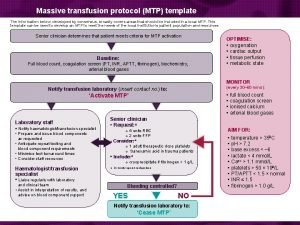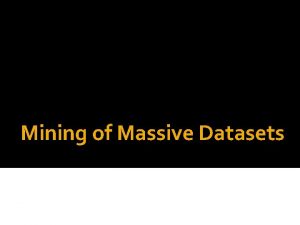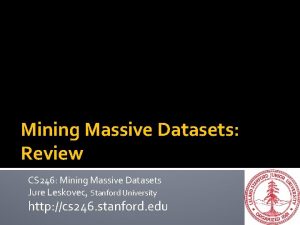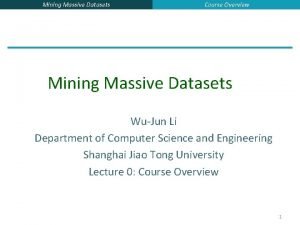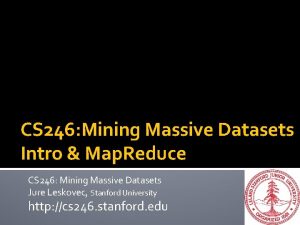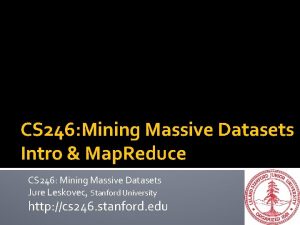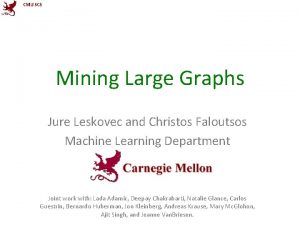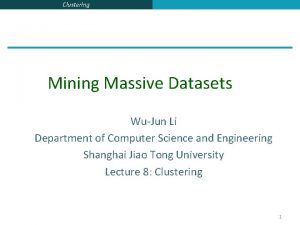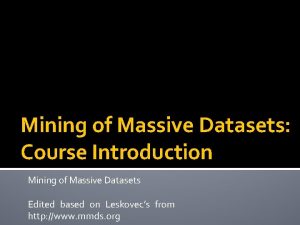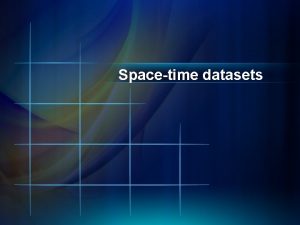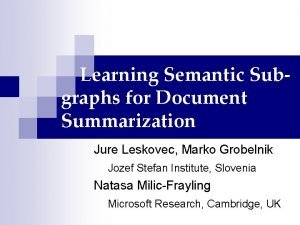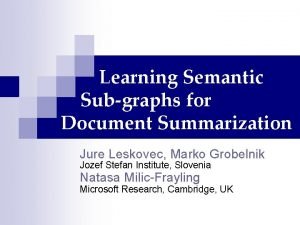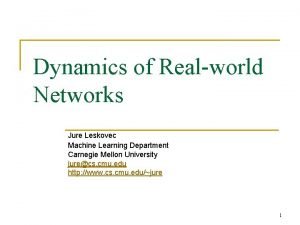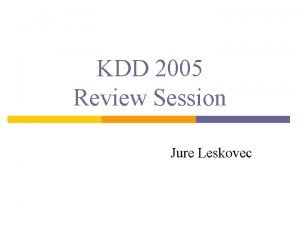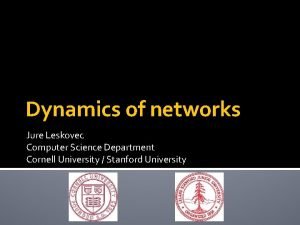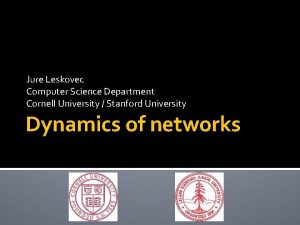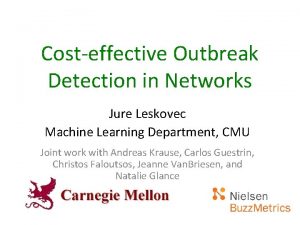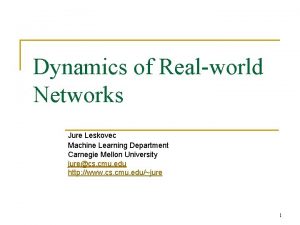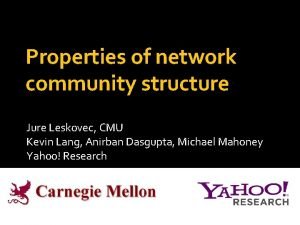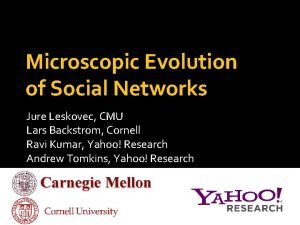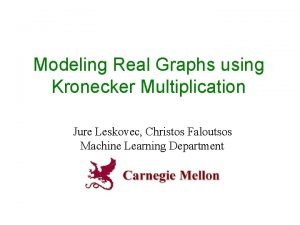Clustering CS 246 Mining Massive Datasets Jure Leskovec

















































- Slides: 49

Clustering CS 246: Mining Massive Datasets Jure Leskovec, Stanford University http: //cs 246. stanford. edu

The Problem of Clustering �Given a set of points, with a notion of distance between points, group the points into some number of clusters, so that § Members of a cluster are close/similar to each other § Members of different clusters are dissimilar �Usually: § Points are in a high-dimensional space § Similarity is defined using a distance measure § Euclidean, Cosine, Jaccard, edit distance, … 2/1/2022 Jure Leskovec, Stanford C 246: Mining Massive Datasets 2

Example: Clusters x x x x xx x x x 2/1/2022 x xx x x x x Jure Leskovec, Stanford C 246: Mining Massive Datasets 3

Why is it hard? �Clustering in two dimensions looks easy �Clustering small amounts of data looks easy �And in most cases, looks are not deceiving �Many applications involve not 2, but 10 or 10, 000 dimensions �High-dimensional spaces look different: almost all pairs of points are at about the same distance 2/1/2022 Jure Leskovec, Stanford C 246: Mining Massive Datasets 4

Clustering Problem: Sky. Cat �A catalog of 2 billion “sky objects” represents objects by their radiation in 7 dimensions (frequency bands) �Problem: Cluster into similar objects, e. g. , galaxies, nearby stars, quasars, etc. �Sloan Sky Survey is a newer, better version of this 2/1/2022 Jure Leskovec, Stanford C 246: Mining Massive Datasets 6

Example: Clustering CD’s �Intuitively: Music divides into categories, and customers prefer a few categories § But what are categories really? �Represent a CD by the customers who bought it �Similar CDs have similar sets of customers, and vice-versa 2/1/2022 Jure Leskovec, Stanford C 246: Mining Massive Datasets 7

Example: Clustering CD’s The difference between LSH and clustering and Dim red. Overall picture: We deal with high dim data. Space of all CDs: �Think of a space with one dimension for each customer § Values in a dimension may be 0 or 1 only § A movie is a point in this space is (x 1, x 2, …, xk), where xi = 1 iff the i th customer bought the CD § Compare with boolean matrix: rows = customers; cols. = CDs �For Amazon, the dimension is tens of millions �An alternative: use minhashing/LSH to get Jaccard similarity between “close” CD’s � 1 minus Jaccard similarity can serve as a distance 2/1/2022 Jure Leskovec, Stanford C 246: Mining Massive Datasets 8

Example: Clustering Documents �Represent a document by a vector (x 1, x 2, …, xk), where xi = 1 iff the i th word (in some order) appears in the document § It actually doesn’t matter if k is infinite; i. e. , we don’t limit the set of words �Documents with similar sets of words may be about the same topic 2/1/2022 Jure Leskovec, Stanford C 246: Mining Massive Datasets 9

Cosine, Jaccard, and Euclidean �As with CD’s we have a choice when we think of documents as sets of words or shingles: § Sets as vectors: measure similarity by the cosine distance. § Sets as sets: measure similarity by the Jaccard distance. § Sets as points: measure similarity by Euclidean distance. 2/1/2022 Jure Leskovec, Stanford C 246: Mining Massive Datasets 10

Overview: Methods of Clustering �Hierarchical: § Agglomerative (bottom up): § Initially, each point is a cluster § Repeatedly combine the two “nearest” clusters into one. § Divisive (top down): § Start with one cluster and recursively split it �Point assignment: § Maintain a set of clusters § Points belong to “nearest” cluster 2/1/2022 Jure Leskovec, Stanford C 246: Mining Massive Datasets 11

Hierarchical Clustering �Key operation: Repeatedly combine two nearest clusters �Three important questions: § How do you represent a cluster of more than one point? § How do you determine the “nearness” of clusters? § When to stop combining clusters? 2/1/2022 Jure Leskovec, Stanford C 246: Mining Massive Datasets 12

Hierarchical Clustering �Key problem: As you build clusters, how do you represent the location of each cluster, to tell which pair of clusters is closest? �Euclidean case: each cluster has a centroid = average of its points § Measure cluster distances by distances of centroids 2/1/2022 Jure Leskovec, Stanford C 246: Mining Massive Datasets 13

Example: Hierarchical clustering (5, 3) o (1, 2) o x (1. 5, 1. 5) x (1, 1) o (2, 1) o (0, 0) o (4, 1) x (4. 5, 0. 5) o (5, 0) Data: o … datapoint x … centroid 2/1/2022 x (4. 7, 1. 3) Jure Leskovec, Stanford C 246: Mining Massive Datasets Dendrogram 14

And in the Non-Euclidean Case? What about the Non-Euclidean case? �The only “locations” we can talk about are the points themselves § i. e. , there is no “average” of two points �Approach 1: clustroid = point “closest” to other points § Treat clustroid as if it were centroid, when computing intercluster distances 2/1/2022 Jure Leskovec, Stanford C 246: Mining Massive Datasets 15

“Closest” Point? Possible meanings of “closest”: �Smallest maximum distance to the other points �Smallest average distance to other points �Smallest sum of squares of distances to other points § For distance metric d clustroid c of cluster C is: 2/1/2022 Jure Leskovec, Stanford C 246: Mining Massive Datasets 16

Defining “Nearness” of Clusters �Approach 2: Intercluster distance = minimum of the distances between any two points, one from each cluster �Approach 3: Pick a notion of “cohesion” of clusters, e. g. , maximum distance from the clustroid § Merge clusters whose union is most cohesive 2/1/2022 Jure Leskovec, Stanford C 246: Mining Massive Datasets 17

Cohesion �Approach 3. 1: Use the diameter of the merged cluster = maximum distance between points in the cluster �Approach 3. 2: Use the average distance between points in the cluster �Approach 3. 3: Use a density-based approach § Take the diameter or avg. distance, e. g. , and divide by the number of points in the cluster § Perhaps raise the number of points to a power first, e. g. , square-root 2/1/2022 Jure Leskovec, Stanford C 246: Mining Massive Datasets 18

Implementation �Naïve implementation of hierarchical clustering: § At each step, compute pairwise distances between all pairs of clusters, then merge § O(N 3) �Careful implementation using priority queue can reduce time to O(N 2 log N) § Still too expensive for really big datasets that do not fit in memory 2/1/2022 Jure Leskovec, Stanford C 246: Mining Massive Datasets 19

k-means clustering

k–means Algorithm(s) �Assumes Euclidean space/distance �Start by picking k, the number of clusters �Initialize clusters by picking one point per cluster § Example: pick one point at random, then k-1 other points, each as far away as possible from the previous points 2/1/2022 Jure Leskovec, Stanford C 246: Mining Massive Datasets 21

Populating Clusters This should be explained better. Is this a single iteration of k-means or is this whole kmeans – Jeff has only 1 iteration (1 step) while here (and in the HW) we explain it as an iterative procedure (until convergence) � 1) For each point, place it in the cluster whose current centroid it is nearest � 2) After all points are assigned, fix the centroids of the k clusters � 3) Optional: reassign all points to their closest centroid § Sometimes moves points between clusters �Usually, repeat 1 -3 until convergence 2/1/2022 Jure Leskovec, Stanford C 246: Mining Massive Datasets 22

Have a better example. It is not clear why points come one after another. Have an example where points change their memberships, we pick initial cluster centers x and then assign and then move x. Example: Assigning Clusters 2 Reassigned points 4 x 6 7 5 x 3 1 8 Clusters after first round 2/1/2022 Jure Leskovec, Stanford C 246: Mining Massive Datasets 23

Make a point that this curve is monotonically decreasing (more clusters is always better) but we hope there is a knee in the curve. Getting the k right How to select k? �Try different k, looking at the change in the average distance to centroid, as k increases. �Average falls rapidly until right k, then changes little Best value of k Average distance to centroid 2/1/2022 Jure Leskovec, Stanford C 246: Mining Massive Datasets k 24

Example: Picking k Too few; many long distances to centroid. x x x x xx x x x 2/1/2022 x xx x x x x Jure Leskovec, Stanford C 246: Mining Massive Datasets 25

Example: Picking k Just right; distances rather short. x x x x xx x x x 2/1/2022 x xx x x x x Jure Leskovec, Stanford C 246: Mining Massive Datasets 26

Example: Picking k Too many; little improvement in average distance. x x x x xx x x x 2/1/2022 x xx x x x x Jure Leskovec, Stanford C 246: Mining Massive Datasets 27

BFR Algorithm Note, clusters are axes aligned ellypses. – give a picture. Gaussuans allow us to measure distance in terms of the likelihood that a point belongs to the cluster. �BFR [Bradley-Fayyad-Reina] is a variant of k-means designed to handle very large (disk-resident) data sets �It assumes that clusters are normally distributed around a centroid in a Euclidean space § Standard deviations in different dimensions may vary 2/1/2022 Jure Leskovec, Stanford C 246: Mining Massive Datasets 28

BFR Algorithm �Points are read one main-memory-full at a time �Most points from previous memory loads are summarized by simple statistics �To begin, from the initial load we select the initial k centroids by some sensible approach 2/1/2022 Jure Leskovec, Stanford C 246: Mining Massive Datasets 29

Initialization: k-means Skip this slide – we already talked about this! �Possible initialization strategies of the cluster centers: k § Take a small random sample and cluster optimally § Take a sample; pick a random point, and then k– 1 more points, each as far from the previously selected points as possible § (As you will learn in HW 2, picking random set of k points does not work too well) 2/1/2022 Jure Leskovec, Stanford C 246: Mining Massive Datasets 30

Three Classes of Points �Discard set (DS): § Points close enough to a centroid to be summarized �Compression set (CS): § Groups of points that are close together but not close to any centroid § These points are summarized, but not assigned to a cluster �Retained set (RS): § Isolated points 2/1/2022 Jure Leskovec, Stanford C 246: Mining Massive Datasets 31

“Galaxies” Picture Points in the RS Compressed sets. Their points are in the CS. A cluster. Its points are in the DS. The centroid Discard set (DS): Close enough to a centroid to be summarized Compression set (CS): Summarized, but not assigned to a cluster Retained set (RS): Isolated points 2/1/2022 Jure Leskovec, Stanford C 246: Mining Massive Datasets 32

Summarizing Sets of Points For each cluster, the discard set is summarized by: �The number of points, N �The vector SUM, whose ith component is the sum of the coordinates of the points in the ith dimension �The vector SUMSQ: ith component = sum of squares of coordinates in ith dimension 2/1/2022 Jure Leskovec, Stanford C 246: Mining Massive Datasets 33

Summarizing Points: Comments � 2 d + 1 values represent any size cluster § d = number of dimensions �Averages in each dimension (the centroid) can be calculated as SUMi /N § SUMi = i th component of SUM �Variance of a cluster’s discard set in dimension i is: (SUMSQi /N ) – (SUMi /N )2 § And standard deviation is the square root of that �Q: Why use this representation of clusters? 2/1/2022 Jure Leskovec, Stanford C 246: Mining Massive Datasets 34

Give some high level overview what’s going on here – how points come in, how they get assigned to sets and what gets merged with what! The “Memory-Load” of Points Processing the “Memory-Load” of points: �Find those points that are “sufficiently close” to a cluster centroid; Add those points to that cluster and the DS �Use any main-memory clustering algorithm to cluster the remaining points and the old RS § Clusters go to the CS; outlying points to the RS Discard set (DS): Close enough to a centroid to be summarized. Compression set (CS): Summarized, but not assigned to a cluster Retained set (RS): Isolated points 2/1/2022 Jure Leskovec, Stanford C 246: Mining Massive Datasets 35

The “Memory-Load” of Points Processing the “Memory-Load” of points (2): �Adjust statistics of the clusters to account for the new points. § Add Ns, SUMSQs �Consider merging compressed sets in the CS �If this is the last round, merge all compressed sets in the CS and all RS points into their nearest cluster Discard set (DS): Close enough to a centroid to be summarized. Compression set (CS): Summarized, but not assigned to a cluster Retained set (RS): Isolated points 2/1/2022 Jure Leskovec, Stanford C 246: Mining Massive Datasets 36

A Few Details… �How do we decide if a point is “close enough” to a cluster that we will add the point to that cluster? �How do we decide whether two compressed sets deserve to be combined into one? 2/1/2022 Jure Leskovec, Stanford C 246: Mining Massive Datasets 37

Allows to make a step from distance to likelihood! How Close is Close Enough? �We need a way to decide whether to put a new point into a cluster �BFR suggest two ways: § The Mahalanobis distance is less than a threshold § Low likelihood of the currently nearest centroid changing 2/1/2022 Jure Leskovec, Stanford C 246: Mining Massive Datasets 38

Mahalanobis Distance � σi … standard deviation of points in the cluster in the ith dimension 2/1/2022 Jure Leskovec, Stanford C 246: Mining Massive Datasets 39

Mahalanobis Distance � 2/1/2022 Jure Leskovec, Stanford C 246: Mining Massive Datasets 40

Picture: Equal M. D. Regions 2/1/2022 Jure Leskovec, Stanford C 246: Mining Massive Datasets 2 41

Should 2 CS clusters be combined? Should 2 CS subclusters be combined? �Compute the variance of the combined subcluster § N, SUM, and SUMSQ allow us to make that calculation quickly �Combine if the variance is below some threshold �Many alternatives: treat dimensions differently, consider density 2/1/2022 Jure Leskovec, Stanford C 246: Mining Massive Datasets 42

The CURE Algorithm �Problem with BFR/k-means: § Assumes clusters are normally distributed in each dimension § And axes are fixed – ellipses at an angle are not OK Vs. �CURE: § Assumes a Euclidean distance § Allows clusters to assume any shape 2/1/2022 Jure Leskovec, Stanford C 246: Mining Massive Datasets 43

Example: Stanford Salaries h h h e e salary e e h e h h e e e h h h age 2/1/2022 Jure Leskovec, Stanford C 246: Mining Massive Datasets 44

Starting CURE �Pick a random sample of points that fit in main memory � 1) Initial clusters: § Cluster these points hierarchically – group nearest points/clusters � 2) Pick disperse points: § For each cluster, pick a sample of points, as dispersed as possible § From the sample, pick representatives by moving them (say) 20% toward the centroid of the cluster 2/1/2022 Jure Leskovec, Stanford C 246: Mining Massive Datasets 45

Example: Initial Clusters h h h e e h e salary h e e e h h h age 2/1/2022 Jure Leskovec, Stanford C 246: Mining Massive Datasets 46

Example: Pick Dispersed Points h h h e e h e salary h e e e h h h Pick (say) 4 remote points for each cluster. age 2/1/2022 Jure Leskovec, Stanford C 246: Mining Massive Datasets 47

Example: Pick Dispersed Points h h h e e h e salary h e e e h h h Move points (say) 20% toward the centroid. age 2/1/2022 Jure Leskovec, Stanford C 246: Mining Massive Datasets 48

Finishing CURE �Now, visit each point p in the data set �Place it in the “closest cluster” § Normal definition of “closest”: that cluster with the closest (to p) among all the sample points of all the clusters. 2/1/2022 Jure Leskovec, Stanford C 246: Mining Massive Datasets 49

Summary �Clustering: Given a set of points, with a notion of distance between points, group the points into some number of clusters �Algorithms: § Agglomerative hierarchical clustering: § Centroid and clustroid § k-means: § Initialization, picking k § BFR § CURE 2/1/2022 Jure Leskovec, Stanford C 246: Mining Massive Datasets 50
 Mining of massive datasets solution
Mining of massive datasets solution Stanford mining massive datasets
Stanford mining massive datasets Cs 246 stanford
Cs 246 stanford Cs 246
Cs 246 L
L Euclidean distance rumus
Euclidean distance rumus Flat clustering
Flat clustering Leskovec
Leskovec Cf tree in data mining
Cf tree in data mining Clustering data mining
Clustering data mining K-means clustering algorithm in data mining
K-means clustering algorithm in data mining Classification and clustering in data mining
Classification and clustering in data mining Adsl dataset example
Adsl dataset example Resilient distributed datasets
Resilient distributed datasets Sklearn.datasets.samples_generator
Sklearn.datasets.samples_generator Resilient distributed datasets
Resilient distributed datasets Google earth engine datasets
Google earth engine datasets Proc datasets noprint
Proc datasets noprint Multimedia data mining
Multimedia data mining Strip mining before and after
Strip mining before and after Mining complex data types
Mining complex data types Difference between strip mining and open pit mining
Difference between strip mining and open pit mining Web text mining
Web text mining Strip mining vs open pit mining
Strip mining vs open pit mining Redondear al dolar mas cercano
Redondear al dolar mas cercano De jure vs de facto
De jure vs de facto It 246
It 246 647 rounded to the nearest hundred
647 rounded to the nearest hundred Jure hren
Jure hren John cho ucla
John cho ucla Subject of international law
Subject of international law Ivan fairy tail
Ivan fairy tail Jure staničić
Jure staničić Jureumi meaning
Jureumi meaning Hyperglycemie
Hyperglycemie Nvatlas
Nvatlas De jure and de facto sovereignty
De jure and de facto sovereignty Extendible hashing visualization
Extendible hashing visualization Place value of 246
Place value of 246 Jure kokalj
Jure kokalj Ds p van veen
Ds p van veen Afman 10-246
Afman 10-246 En un zoológico hay 246 aves
En un zoológico hay 246 aves Jure radišek
Jure radišek Respon internasional terhadap kemerdekaan
Respon internasional terhadap kemerdekaan Estandar de iure
Estandar de iure Jure petric
Jure petric Seabed massive sulphides (sms)
Seabed massive sulphides (sms) How did the cold war begin
How did the cold war begin Massive transfusion protocol template
Massive transfusion protocol template
